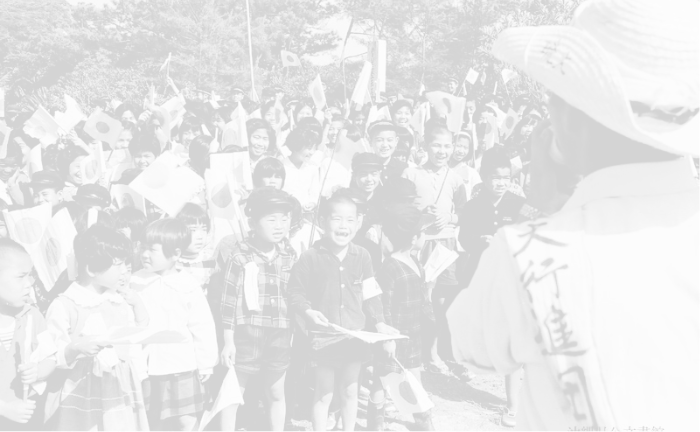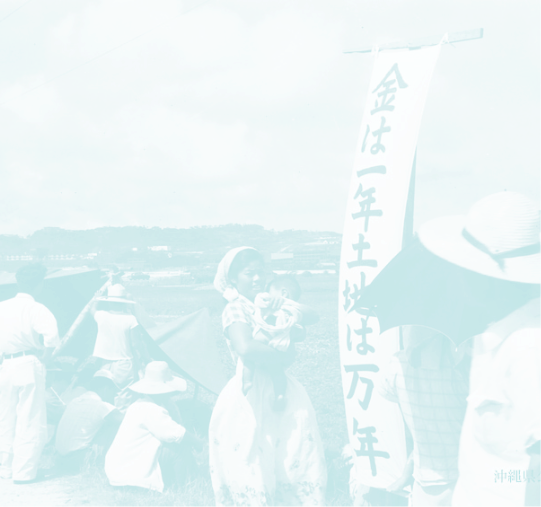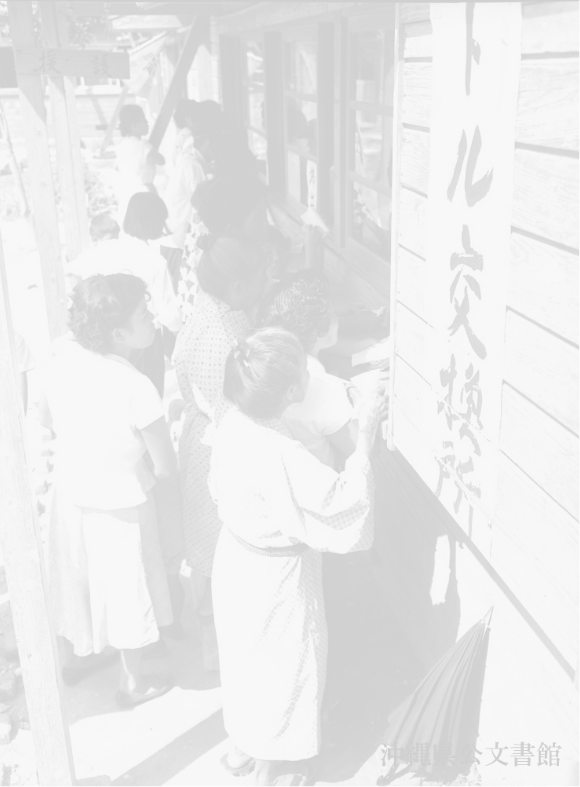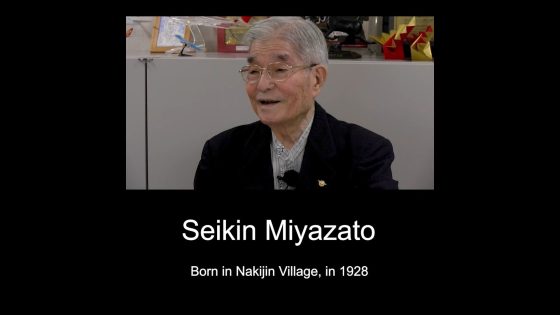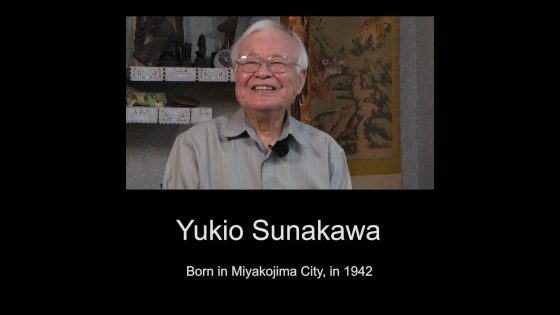
Umbrella Shop Business that Started from Street Selling
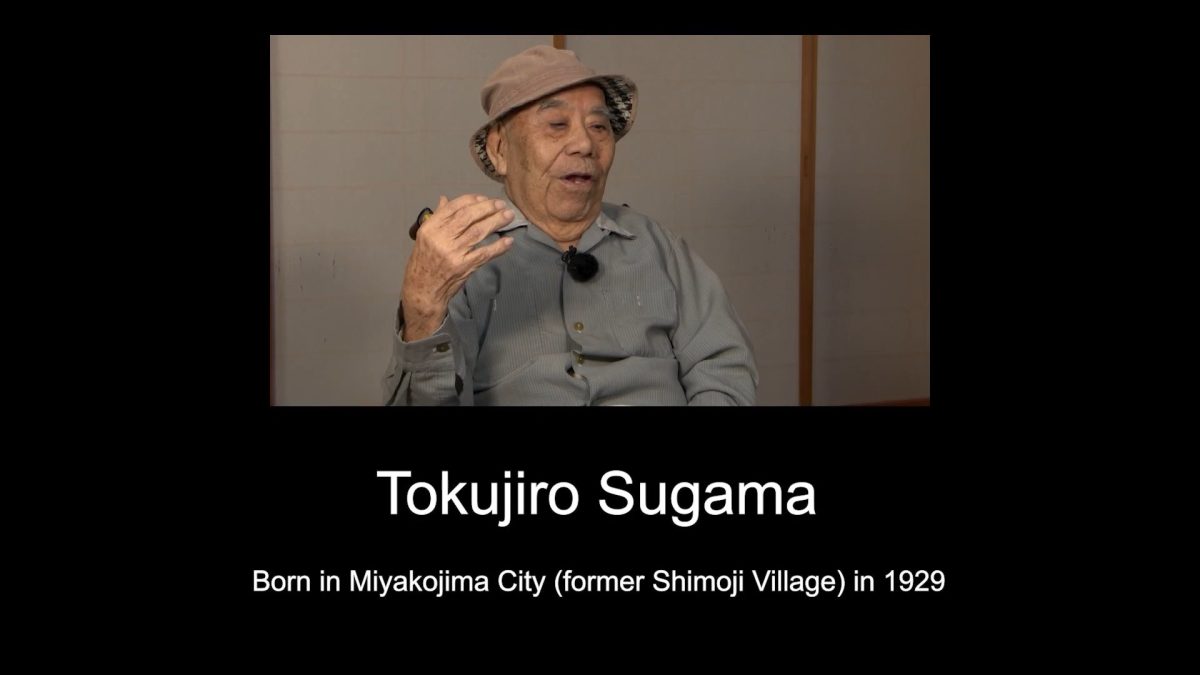

- Born in 1929
- Tokujiro Sugama
Timeline
| 1929 |
Born in Shimoji Village on Miyako Island.
|
|
|---|---|---|
| 1945 |
Experienced war on Miyako Island.
|
|
| 1952 |
Moved from Miyako Island to Naha at the age of 23.
|
|
| 1958 |
Legal tender was changed to B yen and dollars.
|
|
| 1960 |
The Gabu River Shopping District Association consisting of four districts was established.
|
|
| 1962 |
Repair work begun as part of the Gabu River flood control project.
|
|
| 1963 |
Reconstruction of the Garb River waterfront store begun.
|
|
| 1965 |
Repair work on the above-river stores at the Gabu River was completed.
|
|
| 1972 |
On May 15, Okinawa's administrative rights were returned to Japan. (Reversion of Okinawa)
|
Story
Brief biography of the witness
Born on Miyako Island, he moved to Naha after the war. After working as a security guard for the U.S. military, he began selling umbrellas in the small town of Naha, and for many years operated an umbrella shop on Gabu River. He has served on the board of the Gabu River Central Shopping District Association and has witnessed the changes in Naha's post-war neighborhoods.
War experience on Miyako Island
I was born in a community called Kadekaru in Shimoji Village on Miyako Island in 1929. When I was a child, three meals a day were sweet potatoes. The only time I ate rice was during Obon and New Year.
Miyako Island during the War
I heard that during the war, there were more Japanese soldiers than the population of Miyako. There were rumors that there were more soldiers than Miyako residents to protect Miyako. Miyako Island was small and American planes were always flying overhead. Before that, I had heard that there was the October 10 Air Raid on the main island of Okinawa, and the old Naha city was completely wiped out. The people of the village were called up as a defense force, and about 10 people, including five of my friends and five others who were older, were called up. There was Naka Airfield in Ueno Village, and we were on a hill in part of Naka Airfield. There was an amazing cave (air raid shelter.) The great soldiers of Miyako were in that shelter. At that time, I was a child who had just graduated from elementary school. I lived in a cave (air raid shelter) near Naka Air Base for about a month, polishing the shoes of important people and playing with them. In the meantime, the war ended.
Hard Life Just after the War
When the war ended, the people of Miyako returned from Taiwan (where they were evacuated). Returning to Miyako from overseas, people who had their own fields could eat potatoes. I think the people who were brought back from Taiwan and other places who had no fields had a lot of trouble at that time. I think people who had relatives were somehow able to survive through their connections with relatives. In Miyako Island at that time, there was little food and water, nothing. The situation back then cannot even be compared to life nowadays.
Started business in Naha
From Miyako Island to Naha
I think that's why many people gave up living on Miyako Island and came to Naha. I didn't have to worry about food, but I was young and all my friends had left the island, so, when I was 23, I took a boat to Naha by myself. Naha at that time was full of people. There were people coming back from the mainland, and for some reason after the war, Okinawans were also coming back from the Philippines region. When I was 23 and had just arrived in Naharis worked as a guard for the US military. From around the age of 30, I started selling umbrellas on Heiwa Street.
Started a Business by Street-Selling Umbrellas
In the beginning, I mainly sold parasols for women, but when it rained, I also sold a few men's umbrellas. In the beginning, I only sold about 20 umbrellas a day because I didn't have the money. I would buy some umbrellas and bundle them up and take them to Heiwa Street. The parasols sold well.
Do you know what a Mijoki is (flat rounded winnowing basket)? I also attached strings to my Mijoki, wore it around my neck and sold various trinkets. The biggest profits were during the Lunar Obon and Lunar New Year holidays. The reason I sold things on Heiwa Street was because Naha market was there. The current food market is the third iteration of the building. The food market at that time was located on the southernmost side. There was a miscellaneous goods store across the street and a clothing store on the other side. The street between the miscellaneous goods store and the clothing store was Heiwa Street.
Heiwa Street was down the hill from the original location of the Mitsukoshi department store. There were a lot of people walking along Heiwa Street, so I did street selling there. There was a police box on the corner of Heiwa Street.
It was the Heiwa Street police box. There was always a police officer at that police box. There were a lot of people, and I was selling with my Mijoki and I ended up blocking traffic. The police officer often told me that I was obstructing traffic and so to go home. To make a living, I even lied to police officers, saying that I had children and a wife. There was a time when I complained “how am I supposed to make a living if I don't move? “so I ended up in the police box all day. It was quite difficult.
People who had returned from overseas did business, by selling things on both sides of the Gabu River which flows below the shopping street. They sold fruit or other items. My uncle was also near the police box so I relied on my uncle and did not sit by the river. There was a telephone pole diagonally across from the police box on Heiwa Street. There were pharmacies at both ends. There was a telephone pole on the side of the alley between the pharmacies. It became a hotly contested location for street selling. It became a place where you could sell until the evening by just leaving umbrellas there without having to carry them. There were about 10 people from Miyako selling umbrellas. There were many people from Irabu because there were probably no fields on Irabu Island. There were about 5 or 6 people from Miyako. There were 15 or 16 women from Tomigusuku who had Mijoki for sale. There were only two or three women from Miyako.
Shintenchi Market, Mainly for Clothing
At Shintenchi market, there were many people from the countryside or Yanbaru. I think there were about 500 or 600 women. At that time there were no imported products. From when I was a child to when I became an adult, we lived with products made in Okinawa. There were no shoes, but clothing was available for both men and women. Our clothes came from Shintenchi Market.
Set up shop and sell umbrellas
His own store along the Gabu River
In 1962, there was repair work carried out on the Garb River. I started doing business along the Gabu River about 10 years before that. US military tents were set up by the river and I created a shop and started doing business. Up until then, I did street selling, but a friend of mine had a shop by the Gabu River, and said he was quitting his business so was giving away his store. I was grateful that I was able to take over the store. There was a central market street between the current public market and the Gabu River. There was a wooden bridge where you entered from the market street to Ebisu Street. That wooden bridge is a bridge that crosses Ebisu Street. I don't know who named it, but we called the bridge Ebisu Bridge. I started a small shop next to Ebisu Bridge. After that, I stopped street selling. The store in the tent was passed on to me by a friend, so the rent remained the same, and I paid the rent for the land to Benkyodo. Before long, new above-river stores were built as a result of the construction work on the Gabu River. After that, we paid land rent based on the size of the land. When I started the store, I was able to make a profit because there were no mainland vendors. It's different owning a store. If it's street sales, you can only sell what you can hold in your hands. Once I had a store, even though it was small, I tried various things like hanging pipes on the wall, and I was able to sell things.
Making Umbrellas for Sale
After I had some capital, I bought fabrics that I liked in Osaka. The company I worked with was a wholesaler but also had a factory. That is why I bought some fabric, took it to the factory, and asked them to make umbrellas. We only sold patterned umbrellas. I purchased the fabric from a wholesaler. There were hundreds of kinds of fabrics. Then I went to a fabric store and bought some fabric to make umbrellas.
I made about 1000 umbrellas myself. I also sold products to people in my hometown, Miyako and Yaeyama, so I couldn’t do the retail sales all by myself. We sold quite a lot of products to people in Nago City and Okinawa City. There were dozens of wholesale customers. After I started selling umbrellas, folding umbrellas came out. The umbrellas gradually improved. I sold umbrellas that could be used for both sunny and rainy days
Around the Time of the Vietnam War
There were American-made umbrellas, and Americans often came to buy them too. However, it seems that there were not many umbrellas in Vietnam. There were no one-touch opening umbrellas in Vietnam. American soldiers often got supplies of umbrellas from Okinawa. Apparently, they were Korean soldiers, not Vietnamese soldiers. The umbrellas were kept in their cases without even being taken apart, and each box contained 60 umbrellas. They only bought black umbrellas for men. Korean sailors and soldiers often bought them. At the time, there was a large US military ship called LST (Landing Ship Tank) in what is now Naha Port. The ship was moored with the front of the hull open and cars were able to enter inside. I was asked to put my car inside, so I put my car inside the ship. There were two or three Koreans who could speak a little Japanese. So I took the cardboard box with the umbrellas inside onto the ship instead of loading it at the port, and I saw them carry it to their rooms. It seems that military supplies were loaded from Korea to Okinawa, and military supplies were loaded from Okinawa as well, and then those supplies were loaded and taken to Vietnam. Umbrellas were not used in the military, so I think sailors made money by selling them privately.
From Military Currency to Dollars
When I came to Naha, there was a military currency for the US military called the B yen. When I was around 20 years old, I paid with my military currency and took a boat to Naha. When I first started, I worked as a guard for the US military. Okinawans were paid their salaries in military currency. After the currencies changed, I remember the first time I received dollars. It was when I was selling at Heiwa Street. At that time, I was doing street selling. I was standing on the street, when some ladies from the market went to the bank and exchanged B yen for dollars. I received the money, wondering what is a dollar? I remember that.
Flood of the Gabu River and repair work
Flood of the Gabu River
Before the repair work, during heavy rains, I could hear the sound of the Gabu River. When there was heavy rain or strong winds, I couldn't stay around the river. I was worried, so I went to the store, and the water rose up to my chest and I felt afraid for my life. When I tried to evacuate to Kibougaoka Hill, I thought that it would be closer if I crossed Heiwa Street, so I swam towards it. The police box was a two-story wooden building. A police officer watched me swimming, and shouted “Are you okay?” Back then, I was young and didn't mind swimming. Two police officers said to go help me, but I refused help and I swam away. I swam about 50m to the hill. Kibougaoka hill was higher than the surrounding area, so I swam to it and walked from there. There was no water on Kokusai Street and the road was dry. The next day, the storm had passed and there was no rain, so I went to the store. There was nothing left and the store was full of mud. At that time, I also sold some clothing in addition to umbrellas, and I had built a stand and sold underwear. But everything was washed away by the river flooding twice. It was impossible to pass from Kokusai Street to Tomari Port near Naha Commercial High School. The US military had set up a wire fence to surround it, so there was nowhere to cross. So the people of the above-river stores at the Gabu River had nowhere to go. At that time, both sides of the Gabu River were damaged. Hundreds of people were affected, and then a petition for repair was started.
Petition for Gabu River Flood Control Project
Everyone from Kokusai Street to Noren Market worked together, and made an association which included 600 people. A group of important people formed an association and petitioned the Ryukyu government at the time, carrying placards. I think we spent about two years petitioning the Ryukyu government at the time, saying, “Please repair the Gabu River.” “Because of this river, the locals are suffering so much.” We petitioned the Ryukyu government and Naha City Hall. The leader of the petition was Genmei Maeshiro. He was the president of a publishing company in Okinawa. Other leaders were Takehide Kuroshio and Zenko Yamashiro. Zenko Yamashiro was a member of the Prefectural Assembly. The leader of the association was Takehide Kuroshio. Although he was not a politician, he tried really hard. We always gathered at Yogi Park and then went to the Ryukyu government. We petitioned the Ryukyu government and Naha City Hall many times, but all I did was carry a placard and follow along. Mr. Maeshiro and his colleagues negotiated with the chief executive and the mayor of Naha. I was in my late 30sand I became an officer of the association, and my name still remains as an officer.
Gabu River Repair Work Begins
After that, the Ryukyu government negotiated with USCAR (United States Civil Government) and received construction costs. It was managed by the US Civil Government, so they were very strict during the construction. In the shopping street from Kokusai Street to Nouren Market, the area where it splits into Heiwa Street was Block 1. There was Block 2 from there until it split into Shin-ei Street. From there it was Block 3 from Kainan to the point where it goes down. Beyond that was Block 4, which is currently divided into 4 areas. Construction began in Block 2. It finished above Noren Market, and it took three or four years. By the time the river repair work was completed, we were told by the Ryukyu government at the time that they wanted us to clean up the Gabu River as well. In exchange, we wanted them to let us build a building on the Gabu River. We petitioned for a building to be built above the Gabu River from Kokusai Street to Nouren Market. They dug about 10m from the river bank and drove piles in on both sides. If you didn't put the metal piles together and drive the piles in, there was a risk of it collapsing when you dug to 10m. The piles were driven in at least 10 meters and then dug. The piles were driven into both sides. At first, there were some areas that collapsed because the holes were not dug deep enough. At first, we were working on putting in four or five telephone poles, but we didn't have them. So we were driving in metal piles. There wasn't enough piles for that, so we connected them and put piles in for support and then dug. The foundations were filled with concrete about 10m below and it was constructed to allow a large amount of water to flow through it. After carefully pouring concrete from both sides, we put in concrete to prevent the piles from falling and then put a cover over the river. After that, we pulled out the piles that we had driven in. The width of the concrete was 6m. I don't think the slab was that thick. The slab over the Gabu River was about 50 cm thick. If you want to see the width of the slab, you can go to Kamihara Elementary School and Kamihara Junior High School. If you look there at the entrance to the culvert, you should be able to see the thickness of the slab. There and at Junkudo, you should be able to see the slab up to that point. There is a road from Kokusai Street in Naha City to Junkudo. The Gabu River flows under that road. There were roads on both ends of the river. Over there, a road was built to match its width to fill in the top of the Gabu River. Above-river stores were built on the river, effectively joining the roads on both banks. Construction of the Gabu River was completed after three years starting in 1962. After the Gabu River was repaired, it no longer flooded.
Construction of a store on the Gabu River
Construction of Above-river Stores
I think the construction of the above-river stores was difficult. After discussions, we decided to ask Nanyo Doken to build the buildings. The Ryukyu government at the time did not charge a design fee. They paid for the design fee from Kokusai Street to Nouren Market. However, the construction site was divided into four areas. I believe there was also consultation with the US civil government. The design of the second floor of the above-river stores was carried out by the Ryukyu government at the time. The location where my shop was located (Block 2) was good, so Mr. Kuroshio played a central role in expanding the 3rd floor of Block 2. Also, Mr. Kuroshio owns a large store in Nouren Market, so he built Block 4 where Noren Market was located up to the third floor. There was no third floor in Block 1 and Block 3. The building was built up to the second floor according to the design instructed by the Ryukyu government. Block 2 was also built all the way to the second floor. We asked the association for a design, and the third floor was built later. When construction was carried out on the Gabu River, the shutters of the new above-river stores were sturdy. The current shutters are fragile. In reality, the shutters should stand straight. It is said that by creating a slant like this, the shutter can be made many times stronger, according to the Building Standards Act. So the pillars for the shutters should be straight, right? Normal shutters are meant to be lowered straight down. The shutters at that time had a slant like this. It seems that when there is a slant like this, it has three times more force than when it is straight. The shutters designed by the Ryukyu government were in this style. That's why the shutter pillars are slightly slanted. I was happy that the above-river stores were completed. After that, there were times of heavy rain and strong winds, but there was only about 15cm of water in front of my store. I don't think I ever thought that the area around the Gabu River would become a prime location in Naha. It was like a swamp. Apparently, during the rainy season, it was a swamp and no one could enter. Because of the water, no-one could cultivate their fields, they couldn't do anything.
The Present Above-river Stores and the Transition of the City
After Nanyo Doken was contracted for the construction, the owners of each store built above-river stores themselves. That's why perhaps many people have heard that the above-river store building belongs to the national or prefectural government, or it belongs to the city. Few people know that it is private. The Ryukyu government didn't pay a penny. The space I had was small, but I borrowed space from around me and used it to make it bigger. Some people large stores, about 82.5㎡. That's why many people who buy above-river stores rent out the whole space. Many people who receive the land rent it out because they get the rent. There are fewer than 10 people who created an above-river store themselves and are still running it. This is the case in the example of Block 2 where my shop is located. The above-river stores all belong to the people who ran the stores. However, more than 50 years have passed since then, and many people have passed away. Also, it seems that many people purchase stores because the store's location is good. Many parents who own the property pass it on to their children. The current owners of the stores are a range of people. Many people bought them, and many people received them afterwards.
RELATED
Involvement in Social Education Activities in Miyako after the War
- Born in 1942
- Yukio Sunakawa
